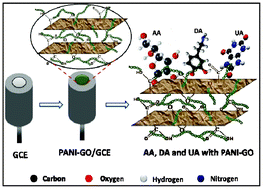Conducting polyaniline-graphene oxide fibrous nanocomposites: preparation, characterization and simultaneous electrochemical detection of ascorbic acid, dopamine and uric acid
Abstract
Polyaniline/graphene oxide (PANI-GO) fibrous nanocomposites have been prepared and the electrochemical catalytic activity towards the electro-oxidation of ascorbic acid (AA), Dopamine (DA) and Uric acid (UA) has been investigated. The nanocomposites were synthesized via an in situ chemical polymerization method. The morphology, composition, thermal and electrochemical properties of the resulting nanocomposites were characterized by scanning electron microscopy, X-ray diffraction, Raman spectroscopy, FT-IR spectroscopy, thermo gravimetric analysis and cyclic voltammetry. The catalytic behavior of PANI-GO nanocomposite modified glassy carbon electrode (GCE) towards AA, DA and UA has been investigated by cyclic voltammetry (CV), differential pulse voltammetry (DPV). The PANI-GO/GCE showed excellent catalytic activity towards electrochemical oxidation of AA, DA and UA compared to the bare GCE. The electrochemical oxidation signal of AA, DA and UA are well separated into three distinct peaks with peak potential separation of 343 mV, 145 mV and 488 mV between AA-DA, DA-UA and AA-UA respectively in CV studies and the corresponding peak potential separation in DPV mode are 320 mV, 230 mV and 550 mV. Under the optimized DPV experimental conditions, the peak current of AA, DA and UA give linear response over the range of 25–200 μM (R2 = 0.9955), 2–18 μM (R2 = 0.9932) and 2–18 μM (R2 = 0.9902) with detection limit of 20 μM, 0.5 μM and 0.2 μM at S/N = 3, respectively. The attractive features of PANI-GO provide potential applications in the simultaneous detection of AA, DA and UA. The excellent electrocatalytic behavior of PANI-GO may lead to new applications in electrochemical analysis.


 Please wait while we load your content...
Please wait while we load your content...